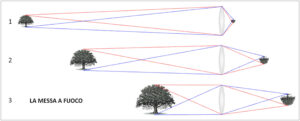Focusing is a term that refers to the process of adjusting a camera, camera, or human eye so as to obtain a clear, sharp image of a subject. This process is fundamental in photography, cinematography and visual observation as it determines the sharpness and clarity of the image captured or observed.
In photography and cinematography, focusing involves adjusting the camera or camcorder lens to ensure that the main subject is rendered sharply while other elements of the image may appear blurry or out of focus. This effect of blurring the area around the main subject is known as “background blur” or “bokeh blur” and is often used to highlight the subject.
In visual observation, such as that which occurs with the human eye, focusing is the process of adjusting the shape of the lens inside the eye so that the light coming from the subject is precisely focused on the retina . This allows you to see the subject sharply and clearly.
Focus can be adjusted to highlight different planes of the image or to achieve creative effects, such as selective focus in photography, where only a specific part of the image is sharp. Additionally, many cameras and camcorders offer autofocus features, which use algorithms and sensors to adjust focus quickly and accurately.
To take photos with perfect focus, it is important to pay attention to several technical aspects and photographic technique.
Use manual focus (MF) when needed: Auto focus (AF) is useful in most cases, but there may be situations where you want to manually control the focus, such as when you need precision or you’re working with static subjects. Select focus point: Many cameras allow you to select the desired focus point. You can choose a specific focus point to focus on the main subject. Use the viewfinder: Whenever possible, use the viewfinder instead of the LCD screen. The viewfinder offers a more stable and direct view of the subject, making it easier to focus precisely. Use a Tripod: If you are photographing static subjects or situations where a long exposure is needed, using a tripod will help maintain stability and achieve precise focus. Use a small aperture (high f-number): If you’re looking to achieve a larger depth of field (more sharp image elements), choose a small aperture, such as f/8 or larger. This requires more light and may require a longer exposure time. Use selective autofocus: Many cameras offer selective focus modes that allow you to choose a specific zone for focus. This is useful when you want to highlight a particular subject. Check the lighting: Make sure there is good lighting, as focusing can be more difficult in low light. Use a flash, auxiliary lighting or use natural light effectively. Use the magnifying (zoom in) feature to check focus: Many cameras allow you to magnify the image on the LCD screen or in the viewfinder to check focus. This feature allows you to see details more precisely. Learn to use “focus peaking”: Some digital cameras offer a feature called “focus peaking,” which highlights the focus contours on the image displayed on the screen. Practice and Experiment: Practice is essential to improving your ability to focus. Experiment with different settings and techniques to find what works best for your needs.
Focus is a crucial part of photography and takes time and practice to become an expert photographer in managing focus in a variety of situations.
In conclusion, focus is a fundamental element in photography and cinematography, as well as in visual observation. Accurate focusing is essential for obtaining sharp, clear images, highlighting the main subject and creating desired visual effects.
To achieve precise focus, it is important to follow these key points:
Choose the appropriate focus mode, which can be automatic or manual, depending on the situation. Select the desired focus point within the image. Frame your subject and make sure the camera is stable, for example by using a tripod. Turn on the focus, check the sharpness and adjust if necessary. Configure exposure settings based on conditions and desired effects. Take the photo and check the preview to make sure you’ve achieved the desired focus.
Constant practice and experimenting with different scenarios and settings are crucial to improving your focusing skills. Focus is not just about technique, but also about creativity, as it can be used to guide the viewer’s attention or create unique visual effects.
In summary, precise focus is an essential aspect of creating high-quality images, requiring attention to detail, patience and practice.
